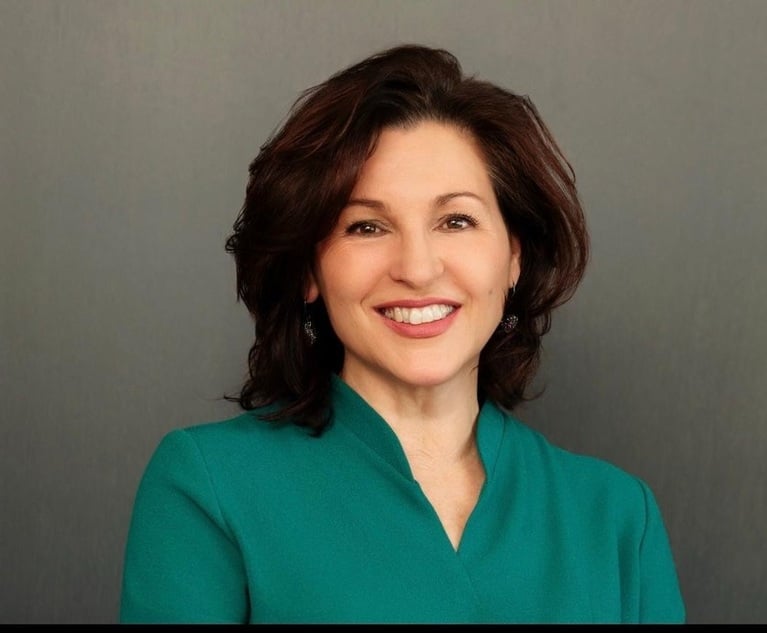UK Gender Pay Gap Prompts Two Firms To Review Parent Policies
Ashurst and Hogan Lovells say the gender pay gap debate has helped open discussion on much wider issues.
April 08, 2019 at 04:00 AM
4 minute read
 Photo: Halfpoint/Shutterstock.com
Photo: Halfpoint/Shutterstock.com
Ashurst and Hogan Lovells are reviewing policies designed to change attitudes and aid women's success in the workplace, following the release of their latest gender pay gap figures.
Ashurst is reviewing its U.K. shared parental leave and global maternity policies, with the aim of increasing the number of men taking part in the U.K. scheme and having a more integrated global maternity programme.
Hogan Lovells is examining the transition arrangements for those returning from parental leave and is considering the potential impact of work allocation.
At Ashurst, only half the men who have taken paternity leave have also engaged in the firm's shared parental leave programme.
Ashurst head of HR for EMEA and U.S. Claire Townshend told Legal Week the firm wants to "prompt an increase" in those taking part in the scheme, and address any concerns people may have about doing so.
She said: "Wider research has shown that men feel if they take part it may impact on their career prospects – we want it to be normalised in the future and need to engage more with our people to encourage that."
The firm is also reviewing its global maternity policy and aims to offer a more standardised approach across its international offices.
Townshend said: "The firm operates across lots of different countries and areas, where there are many different statutory requirements and policies in practice. We think there is a minimum maternity leave period that we should be offering everywhere globally – not everywhere can be exactly the same of course, but we want to improve maternity leave policies where we can."
She added one particular area of focus for an improved offering is in the firm's Asian offices.
Following discussion and with the approval of Ashurst's executive team, the firm hopes to implement changes to the policies by the first quarter of next year.
Townshend said gender pay gap reporting has helped move the firm's conversations forward.
"Gender pay gap reporting has been a tool for great conversations internally – in the legal sector with a higher proportion of partners being male, having a conversation in the public domain is great. As we try to drive this agenda of ensuring equality, it's very helpful," she said.
Ashurst's gender pay gap figures, released this week (April 4), showed a mean partner gender pay of 15.7 percent last year. It was the first time the firm has split out these figures.
Its mean gender pay gap for legal employees improved on the previous year, dropping to 10 percent in 2018 from 16.4 percent, and the mean bonus pay gap also shrank, to 42.1 percent from 62.6 percent.
Hogan Lovells states within its gender pay gap report that it is currently undertaking a review of the "transition arrangements for returnees, as well as considering the potential impact of work allocation".
While the firm declined to give further details, one female partner at the firm said: "It's about communication and understanding what the pressure points are. Lots of our people have flexed their hours to fit around childcare and we have to bear that in mind. Little things can help – like avoiding regular calls that clash with nursery pickups, for example."
She added: "Flexibility is a two-way thing – you need the lawyer to be prepared to be flexible as well – and a lot of that comes down to having a proper, open conversation about what will work."
Last year, Hogan Lovells paid its female partners more on average for the second year running. But when partner figures were combined with employee numbers, the gender pay gap was 12.3 percent in favour of men and the median gap was 27.3 percent.
The firm was one of few to expand its reporting to include ethnicity figures. The mean ethnicity pay gap for combined employees and partners was 46.3 percent, with a median gap of 33.2 percent. For partners, the mean ethnicity pay gap was 12.8 percent.
This content has been archived. It is available through our partners, LexisNexis® and Bloomberg Law.
To view this content, please continue to their sites.
Not a Lexis Subscriber?
Subscribe Now
Not a Bloomberg Law Subscriber?
Subscribe Now
NOT FOR REPRINT
© 2025 ALM Global, LLC, All Rights Reserved. Request academic re-use from www.copyright.com. All other uses, submit a request to [email protected]. For more information visit Asset & Logo Licensing.
You Might Like
View All
Hengeler Advises On €7B Baltica 2 Wind Farm Deal Between Ørsted and PGE
2 minute read

A&O Shearman To Lose Another Five Lawyers, Including Madrid Practice Head, to EY
3 minute read
Rosenblatt Breaks Away From RBG, Becomes 40-Strong Standalone Firm
Trending Stories
- 1Uber Files RICO Suit Against Plaintiff-Side Firms Alleging Fraudulent Injury Claims
- 2The Law Firm Disrupted: Scrutinizing the Elephant More Than the Mouse
- 3Inherent Diminished Value Damages Unavailable to 3rd-Party Claimants, Court Says
- 4Pa. Defense Firm Sued by Client Over Ex-Eagles Player's $43.5M Med Mal Win
- 5Losses Mount at Morris Manning, but Departing Ex-Chair Stays Bullish About His Old Firm's Future
Who Got The Work
J. Brugh Lower of Gibbons has entered an appearance for industrial equipment supplier Devco Corporation in a pending trademark infringement lawsuit. The suit, accusing the defendant of selling knock-off Graco products, was filed Dec. 18 in New Jersey District Court by Rivkin Radler on behalf of Graco Inc. and Graco Minnesota. The case, assigned to U.S. District Judge Zahid N. Quraishi, is 3:24-cv-11294, Graco Inc. et al v. Devco Corporation.
Who Got The Work
Rebecca Maller-Stein and Kent A. Yalowitz of Arnold & Porter Kaye Scholer have entered their appearances for Hanaco Venture Capital and its executives, Lior Prosor and David Frankel, in a pending securities lawsuit. The action, filed on Dec. 24 in New York Southern District Court by Zell, Aron & Co. on behalf of Goldeneye Advisors, accuses the defendants of negligently and fraudulently managing the plaintiff's $1 million investment. The case, assigned to U.S. District Judge Vernon S. Broderick, is 1:24-cv-09918, Goldeneye Advisors, LLC v. Hanaco Venture Capital, Ltd. et al.
Who Got The Work
Attorneys from A&O Shearman has stepped in as defense counsel for Toronto-Dominion Bank and other defendants in a pending securities class action. The suit, filed Dec. 11 in New York Southern District Court by Bleichmar Fonti & Auld, accuses the defendants of concealing the bank's 'pervasive' deficiencies in regards to its compliance with the Bank Secrecy Act and the quality of its anti-money laundering controls. The case, assigned to U.S. District Judge Arun Subramanian, is 1:24-cv-09445, Gonzalez v. The Toronto-Dominion Bank et al.
Who Got The Work
Crown Castle International, a Pennsylvania company providing shared communications infrastructure, has turned to Luke D. Wolf of Gordon Rees Scully Mansukhani to fend off a pending breach-of-contract lawsuit. The court action, filed Nov. 25 in Michigan Eastern District Court by Hooper Hathaway PC on behalf of The Town Residences LLC, accuses Crown Castle of failing to transfer approximately $30,000 in utility payments from T-Mobile in breach of a roof-top lease and assignment agreement. The case, assigned to U.S. District Judge Susan K. Declercq, is 2:24-cv-13131, The Town Residences LLC v. T-Mobile US, Inc. et al.
Who Got The Work
Wilfred P. Coronato and Daniel M. Schwartz of McCarter & English have stepped in as defense counsel to Electrolux Home Products Inc. in a pending product liability lawsuit. The court action, filed Nov. 26 in New York Eastern District Court by Poulos Lopiccolo PC and Nagel Rice LLP on behalf of David Stern, alleges that the defendant's refrigerators’ drawers and shelving repeatedly break and fall apart within months after purchase. The case, assigned to U.S. District Judge Joan M. Azrack, is 2:24-cv-08204, Stern v. Electrolux Home Products, Inc.
Featured Firms
Law Offices of Gary Martin Hays & Associates, P.C.
(470) 294-1674
Law Offices of Mark E. Salomone
(857) 444-6468
Smith & Hassler
(713) 739-1250








